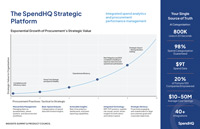5 Reasons To Ditch Your Procurement Savings Tracking in Excel
Is tracking Procurement savings in Excel still efficient?
Spoiler alert: the answer is, of course, no.
In the old days, Excel was the holy grail for tracking your procurement savings. However, times have changed and there are new, improved options available. Unfortunately, many procurement leaders still use Excel spreadsheets for procurement performance tracking.
Of course, Excel does come with a few benefits:
- It’s very cheap, and at a basic level it’s easy to use.
- Excel can house and work with a lot of data.
- It’s a business-suite mainstay, meaning team members are familiar with-it organization-wide.
- Custom formulas and macros make it flexible and customizable.
However, there are a few significant disadvantages that make Excel a bad fit for procurement teams:
- You can’t rely on Excel: When you’re working with thousands of rows and columns of data, a single error can (and will) be fatal. Unfortunately, these errors are common when you’re manually entering data. Moreover, locating a single error in this sea of data can be challenging and time-consuming. Data in Excel isn’t always easy to interpret, either. Because its interface only provides the row data with no further analysis or dashboard. Planning with Excel can get really complicated.
- It is nearly impossible to follow the progress of a project and to manage a team on an Excel spreadsheet. Excel is rarely cited for its collaborative capabilities. While modern tools like Google Sheets or Microsoft SharePoint allow multiple users to edit a document concurrently, their use as a project management tool ends there.
- Excel is far from being a Savings Tracking tool. Spreadsheets are powerful tools that come with endless customization options and formulas. However, they don’t fix the core problem: spreadsheets weren’t designed for Procurement. At best, they’re a loose fit. At worst, they can throw your spend information into chaos when someone inevitably makes a mistake while entering data.
On the surface, Excel seems effective at managing procurement teams and activities. However, its use is severely limited because it wasn’t designed for Procurement. There are too many disadvantages that make data tracking unreliable, tedious, and non-collaborative.
Leveraging a tool designed for securing, sharing, collaborating, and measuring procurement performance
If you want a platform that will enable you to collaboratively secure, share, and measure procurement performance, SpendHQ’s Procurement Performance Management (PPM) is the answer you’re looking for. By organizing strategic sourcing processes into an intuitive workflow, PPM makes it easy to forecast potential savings, update them as projects progress, and then reliably communicate their impact on the business. In short, it empowers procurement professionals to:
- Build cross-team collaboration with centralized data.
- Access up-to-date information in one click without working in a spreadsheet.
- Streamline reporting and focus your energy on projects that drive results.
- Leverage transparency to establish new levels of trust with finance and other internal stakeholders.
- Share and validate savings and cost avoidances with true procurement savings tracking.
In the end, Procurement acts as an interface between a company’s internal and external stakeholders. More than potentially any other department, Procurement sits in the middle of the relationship between internal stakeholders, suppliers, business units, and finance, just to name a few. Because Procurement holds so much responsibility, it has a critical need for a tool it can rely on to plan, execute, and report on initiatives.
Traditionally, procurement leaders have relied on spreadsheets for this purpose, and they have been let down repeatedly. Now it’s time for procurement professionals to harness a tool built for their daily operations. SpendHQ’s Procurement Performance Management is that tool. If you’re ready to improve your efficiency, set the standard for collaboration, and build bridges of trust in your organization, click here now to schedule a demo and discover how PPM can redefine the way you demonstrate Procurement’s success.




